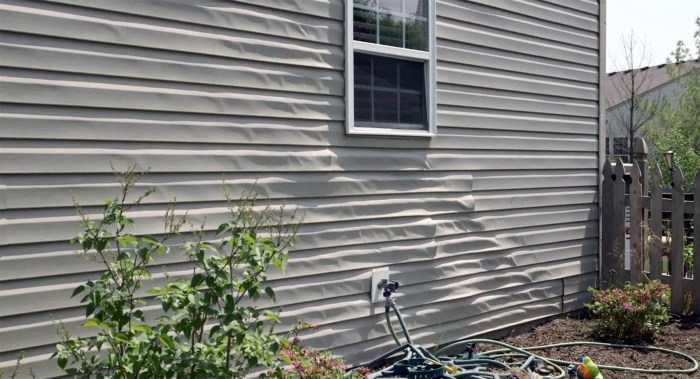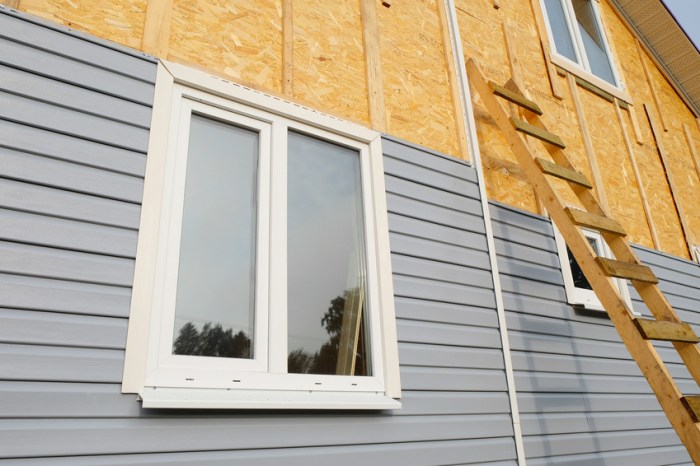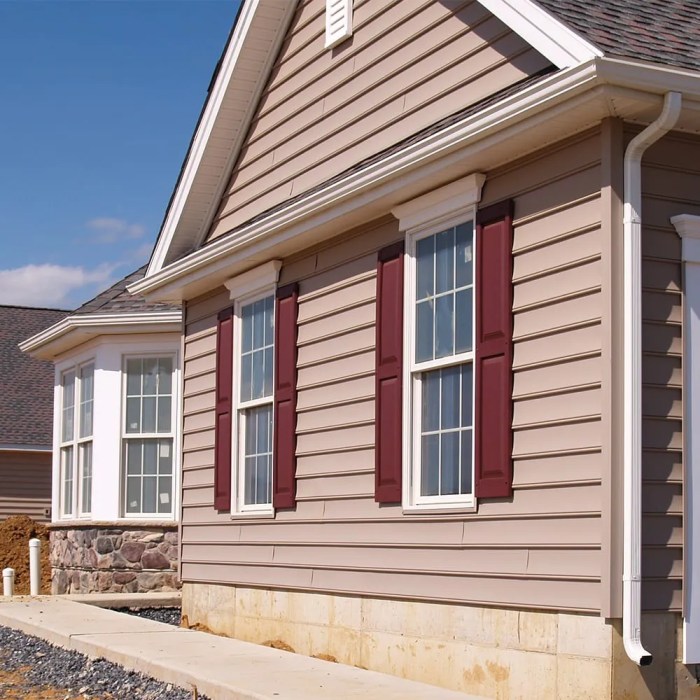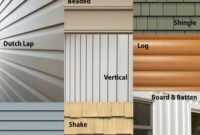Dutch lap vinyl siding offers a classic, charming aesthetic for homes and businesses. Its distinctive overlapping profile creates a visually appealing texture, reminiscent of traditional wood siding but with the low-maintenance benefits of vinyl. This guide delves into everything you need to know about Dutch lap vinyl siding, from its manufacturing process and installation to its advantages, disadvantages, and environmental impact. We’ll explore the various design options available and help you determine if this siding choice is right for your project.
We’ll compare Dutch lap siding to other popular vinyl styles like clapboard and shingle, examining the differences in appearance, cost, and longevity. Understanding the nuances of installation, maintenance, and the long-term durability of this material is crucial for making an informed decision. We’ll also cover the environmental considerations related to vinyl siding production and disposal, offering insights into sustainable alternatives.
Understanding Dutch Lap Vinyl Siding
Dutch lap vinyl siding offers a classic and aesthetically pleasing exterior for homes. Its distinctive profile and ease of installation make it a popular choice among homeowners and contractors alike. This section delves into the characteristics, manufacturing, and comparisons of Dutch lap vinyl siding with other options.
Dutch Lap Vinyl Siding Characteristics
Dutch lap vinyl siding is characterized by its distinctive overlapping panels, reminiscent of traditional wood lap siding. Each panel features a slightly wider top edge than its bottom edge, creating a staggered, shadow-line effect that adds depth and visual interest to the exterior wall. This profile provides a more substantial appearance than other vinyl siding styles, such as clapboard, and offers improved protection against the elements. The panels are typically installed horizontally, with the wider top edge overlapping the narrower bottom edge of the panel above.
Manufacturing Process of Dutch Lap Vinyl Siding
The manufacturing process involves several steps. First, polyvinyl chloride (PVC) resin is combined with other additives to create a durable and weather-resistant compound. This compound is then extruded into long strips, which are subsequently cut and shaped into individual Dutch lap panels. These panels are then embossed with textures, mimicking the look of wood grain or other natural materials. Finally, the panels are colored using pigments mixed into the PVC compound or applied as a surface coating. The entire process is automated, ensuring consistency and efficiency in production.
Comparison with Other Vinyl Siding Styles
Dutch lap vinyl siding differs significantly from other vinyl siding profiles. Clapboard siding, for example, features a more uniform width across the panel, resulting in a simpler, less textured appearance. Shingle siding, on the other hand, imitates the look of asphalt shingles with individual, smaller panels that create a more textured and varied surface. While all three offer weather protection, Dutch lap siding stands out with its more pronounced shadow lines and classic, upscale aesthetic.
Color and Texture Options
Dutch lap vinyl siding is available in a wide range of colors and textures to suit diverse architectural styles and homeowner preferences. Popular color options range from traditional earth tones like beige, brown, and gray to bolder shades like red, blue, and green. Textures often mimic the look of natural wood, providing a realistic and visually appealing finish. Some manufacturers offer siding with a smooth finish for a more contemporary look. Examples include deep cedar tones, weathered gray, and creamy white.
Cost-Effectiveness Compared to Other Siding Materials
| Siding Material | Initial Cost (per sq ft) | Installation Cost (per sq ft) | Longevity |
|---|---|---|---|
| Dutch Lap Vinyl | $3-$6 | $2-$4 | 20-30 years |
| Wood Siding | $6-$15 | $4-$8 | 15-25 years (with maintenance) |
| Fiber Cement Siding | $8-$15 | $5-$10 | 30-50 years |
| Aluminum Siding | $2-$5 | $2-$4 | 20-30 years |
*Note: Prices are estimates and can vary depending on location, material quality, and installation costs.
Installation and Maintenance of Dutch Lap Vinyl Siding

Dutch lap vinyl siding offers a durable and attractive exterior cladding solution. Proper installation is crucial for ensuring longevity and performance, while regular maintenance prevents issues and maintains its aesthetic appeal. This section details the installation process, addresses common challenges, Artikels maintenance requirements, and explores the siding’s lifespan and durability.
Tools and Materials Required for Dutch Lap Vinyl Siding Installation
Successful installation requires careful planning and the right tools. Essential materials include the vinyl siding itself, J-channel, starter strips, corner trims, window and door trims, flashing, nails or staples (specifically designed for vinyl siding), and caulk. Necessary tools comprise a measuring tape, level, utility knife, hammer or nail gun, drill (for pre-drilling in some cases), and a saw (for cutting siding). Safety glasses and work gloves are essential for personal protection.
Step-by-Step Installation Process
Installation begins with preparing the wall surface, ensuring it’s clean, dry, and free of any loose debris. Next, install the starter strip along the bottom edge of the wall, creating a level base for the first row of siding. Subsequently, install the J-channel around windows, doors, and corners. The first row of siding is then installed, overlapping the starter strip and using appropriate fasteners. Each subsequent row is installed similarly, overlapping the previous row, ensuring proper alignment and maintaining consistent spacing. Remember to use the correct fasteners and avoid over-driving them, which can damage the siding. Proper flashing is crucial around windows and doors to prevent water penetration. Finally, install the finishing trim pieces to complete the installation.
Common Installation Challenges and Solutions
Uneven walls pose a significant challenge. Careful measurement and adjustments during installation are crucial. Using shims can help level the siding, while pre-drilling holes in the siding can help prevent cracking. Another challenge involves cutting siding around windows and doors. Precise measurements and sharp cutting tools are vital to achieve a clean, professional finish. Poor weather conditions can also affect the installation process. It’s best to install siding during dry, moderate-temperature conditions. Finally, improper fastening can lead to loose siding or damage to the material. Using the correct fasteners and avoiding over-driving nails are essential to prevent these problems.
Maintenance Requirements for Dutch Lap Vinyl Siding
Regular cleaning is essential to maintain the appearance and longevity of the siding. A simple solution of mild detergent and water, applied with a soft brush or sponge, usually suffices. Avoid harsh chemicals or abrasive cleaners, as they can damage the vinyl. Power washing should be done cautiously, using a low-pressure setting to avoid damaging the siding. Regular inspections should identify and address any damage promptly.
Repair Methods for Dutch Lap Vinyl Siding
Minor scratches or dents can often be repaired with touch-up paint. More significant damage, such as cracks or holes, may require replacing individual panels. Replacing a panel involves carefully removing the damaged panel, and installing a new one, ensuring proper overlap and alignment with adjacent panels.
Lifespan and Durability of Dutch Lap Vinyl Siding
Dutch lap vinyl siding is known for its durability and longevity. With proper installation and maintenance, it can last for 20 to 40 years or even longer, resisting damage from various weather conditions, including rain, snow, and sun. However, extreme weather events, such as hailstorms or hurricanes, can cause significant damage, shortening its lifespan. Coastal areas with high salt content can also affect the siding’s longevity.
Regular Maintenance Checklist for Dutch Lap Vinyl Siding
Regular inspections are key to preventative maintenance. A simple checklist can be helpful:
- Inspect siding for damage (cracks, dents, loose panels) at least twice a year, spring and fall.
- Clean siding with mild detergent and water as needed, at least once a year.
- Repair or replace damaged panels promptly.
- Check caulking around windows and doors for cracks and re-caulk as needed.
- Inspect flashing around windows and doors for proper function and replace if necessary.
Advantages and Disadvantages of Dutch Lap Vinyl Siding

Dutch lap vinyl siding, with its distinctive overlapping profile, offers a blend of aesthetic appeal and practicality for residential and commercial buildings. However, like any building material, it presents both advantages and disadvantages that homeowners and builders should carefully consider before making a selection. This section will explore the key benefits and drawbacks of Dutch lap vinyl siding, comparing its performance to other exterior cladding options and examining its impact on overall building aesthetics.
Key Advantages of Dutch Lap Vinyl Siding
Dutch lap vinyl siding boasts several compelling advantages. Its durability is a significant factor, offering excellent resistance to rot, insect infestation, and moisture damage, unlike wood siding which requires regular maintenance and is susceptible to these issues. The low-maintenance nature of vinyl is also a considerable benefit; cleaning typically involves simply hosing down the siding, saving time and money compared to the upkeep required for wood or other materials. Furthermore, vinyl siding is incredibly resistant to fading and discoloration, maintaining its appearance for many years. Finally, the wide range of colors and styles available allows for considerable design flexibility, although this is less extensive than some other siding types.
Potential Drawbacks of Dutch Lap Vinyl Siding
While offering many benefits, Dutch lap vinyl siding also has some limitations. Its susceptibility to damage from strong impacts, such as hail or flying debris, is a significant concern. Unlike some other siding materials, dents and scratches can be difficult to repair, sometimes requiring replacement of entire panels. Additionally, the material’s expansion and contraction with temperature fluctuations can lead to issues with caulking and sealing over time, potentially allowing moisture penetration. Finally, while offering design flexibility, the selection of styles and textures is generally less extensive compared to other siding options such as fiber cement or wood.
Energy Efficiency Comparison
The energy efficiency of Dutch lap vinyl siding is comparable to other vinyl siding options and generally better than wood siding without added insulation. Its ability to create a relatively airtight barrier helps to reduce air infiltration, contributing to improved energy efficiency. However, the energy-saving benefits are largely dependent on the underlying insulation and overall building envelope design. High-performance insulation and proper window sealing are far more significant contributors to overall energy efficiency than the choice of siding alone. For instance, a building with superior insulation and airtight construction using standard vinyl siding will likely outperform a building with inferior insulation and air sealing despite using higher-end Dutch lap vinyl siding.
Pros and Cons List
The following list summarizes the key advantages and disadvantages of Dutch lap vinyl siding:
- Pros: Durability, low maintenance, resistance to rot and insects, wide range of colors, relatively affordable.
- Cons: Susceptibility to impact damage, potential for caulking issues, limited design flexibility compared to some alternatives, can appear less sophisticated than other materials.
Impact on Aesthetic Appeal
The choice of Dutch lap siding significantly influences a building’s aesthetic appeal. Its characteristic overlapping profile creates a classic, somewhat traditional look, often associated with charming homes and cottages. However, the perceived elegance can depend on the color choice, the overall architectural style of the building, and the quality of installation. A poorly installed Dutch lap siding job can detract from the aesthetic appeal, whereas a carefully planned and expertly installed system can greatly enhance the curb appeal of a property. The relatively simple design can be a benefit or drawback depending on the desired aesthetic; it might not be suitable for modern or highly contemporary architectural styles.
Design Considerations for Dutch Lap Vinyl Siding
Dutch lap vinyl siding offers a versatile aesthetic, capable of transforming a home’s exterior dramatically. The choice of color, texture, trim, and accessories significantly impacts the final appearance, aligning the siding with various architectural styles and creating a cohesive, visually appealing design. Careful consideration of these elements is crucial for achieving the desired look and feel.
Color and Texture’s Influence on Building Aesthetics
The color of Dutch lap vinyl siding is paramount in setting the overall tone and mood of a building. Light colors, such as creamy whites, soft grays, and pale blues, create a sense of spaciousness and airiness, particularly effective for smaller homes or those in sunny climates. Darker colors, including deep blues, greens, and browns, offer a more dramatic and sophisticated appearance, often suiting larger homes or those with strong architectural features. The texture also plays a role; smoother surfaces tend to lend a modern, clean look, while textured surfaces can add depth and visual interest, mimicking the appearance of natural wood. A subtle woodgrain texture can enhance the rustic charm of a home, while a smoother finish might better complement a contemporary design.
Suitability of Dutch Lap Siding Across Architectural Styles
Dutch lap siding’s adaptability makes it suitable for a wide range of architectural styles. Its classic profile complements traditional homes, such as Cape Cods and Victorians, lending a timeless elegance. On Ranch-style homes, it provides a clean, understated look, particularly effective with horizontal lines. Even contemporary homes can benefit from Dutch lap siding, provided the color and texture are chosen to reflect the modern aesthetic. The versatility lies in its ability to adapt to different design elements and overall building aesthetics.
Impact of Trim and Accessories on Final Appearance
Trim and accessories are not merely functional; they significantly enhance the visual appeal of Dutch lap siding. Window and door trim, in coordinating or contrasting colors, can create strong visual accents, highlighting architectural details. Fascia boards, soffits, and corner boards, all in complementary styles and colors, contribute to a polished and cohesive look. The choice of accessories, such as shutters and decorative molding, further refines the design, adding character and visual interest. Careful selection of these elements ensures a professional and aesthetically pleasing outcome.
Color Complementing Various House Styles
A Victorian home might be beautifully complemented by a deep, jewel-toned siding color, such as a rich burgundy or deep forest green, accented with crisp white trim and dark shutters. This creates a striking contrast that enhances the home’s ornate details. A Ranch-style home, with its clean lines, could be elegantly enhanced by a light gray or beige siding, perhaps with darker gray trim to provide subtle definition. For a Cape Cod style, a classic white or light blue siding, paired with black shutters and white trim, evokes a timeless New England charm. These color choices create a harmonious relationship between the siding and the overall architectural style.
Three House Facade Designs Featuring Dutch Lap Vinyl Siding
Design 1: A Cape Cod style home features creamy white Dutch lap vinyl siding with crisp black shutters and white trim. The simple elegance of the siding is highlighted by the contrasting colors, creating a classic and timeless aesthetic.
Design 2: A Ranch-style home showcases a light gray Dutch lap vinyl siding with darker gray trim. This subtle color variation provides visual interest without overwhelming the home’s clean lines. The absence of shutters maintains a minimalist, contemporary feel.
Design 3: A Victorian home is dramatically enhanced with deep forest green Dutch lap vinyl siding, complemented by white trim and black shutters. The rich color accentuates the home’s intricate details, creating a visually striking and historically appropriate design.
Environmental Impact and Sustainability

Dutch lap vinyl siding, while offering numerous benefits in terms of durability and aesthetics, presents a complex environmental profile. Its lifecycle, encompassing manufacturing, installation, use, and disposal, significantly impacts the environment, raising concerns about resource depletion, pollution, and long-term sustainability. Understanding these impacts is crucial for making informed decisions about siding choices and promoting environmentally responsible practices.
Manufacturing and Disposal of Dutch Lap Vinyl Siding
The production of vinyl siding relies heavily on fossil fuels, primarily petroleum and natural gas. This process generates greenhouse gas emissions, contributing to climate change. Furthermore, the manufacturing process often involves the use of volatile organic compounds (VOCs), which can contribute to air pollution and have detrimental effects on human health. Disposal presents another challenge; vinyl siding is not readily biodegradable and often ends up in landfills, where it persists for centuries. This contributes to landfill overcrowding and prevents the recovery of valuable materials. The energy required for transportation from manufacturing facilities to installation sites also adds to the overall carbon footprint. For example, a large-scale housing development requiring thousands of square feet of siding would generate a considerably larger carbon footprint than a smaller residential project.
Recyclability of Dutch Lap Vinyl Siding Compared to Other Siding Materials
Compared to other siding materials, the recyclability of vinyl siding is relatively low. While some recycling programs exist, they are not widespread, and the process often involves downcycling—converting the material into lower-grade products. This contrasts with materials like wood, which, while requiring sustainable forestry practices, can be composted or reused in other applications at the end of its life. Aluminum siding, while also requiring energy-intensive production, offers a higher recyclability rate with minimal loss of material quality. Fiber cement siding, though not directly recyclable in the same way as aluminum, contains components that can be recycled separately. The overall recyclability of vinyl siding lags behind these alternatives, emphasizing the need for improved recycling infrastructure and innovative recycling technologies.
Potential for Using Recycled Materials in Vinyl Siding Production
The potential for incorporating recycled materials in the production of Dutch lap vinyl siding is an area of ongoing research and development. Some manufacturers are exploring the use of post-consumer recycled PVC in their products, aiming to reduce reliance on virgin materials. However, the percentage of recycled content in most vinyl siding remains relatively low, and the quality of recycled PVC can sometimes affect the durability and performance of the final product. Increased investment in research and development, coupled with government incentives and consumer demand for sustainable products, could drive greater adoption of recycled materials in vinyl siding manufacturing. Successful implementation would significantly reduce the environmental impact of vinyl siding production.
Environmentally Friendly Alternatives to Vinyl Siding
Several environmentally friendly alternatives to vinyl siding exist, offering varying levels of sustainability. These include wood siding from sustainably managed forests, which is a renewable resource and can be biodegradable. Fiber cement siding, while requiring energy-intensive production, offers a longer lifespan and lower maintenance requirements compared to vinyl. Reclaimed wood offers an even more sustainable option, reducing waste and using existing resources. Metal sidings, particularly aluminum, are also recyclable and durable, although their manufacturing process also has environmental impacts. The choice of alternative depends on factors such as budget, aesthetic preferences, and regional availability of sustainable materials.
Eco-Conscious Practices Related to Installation and Disposal of Vinyl Siding
Careful consideration of installation and disposal practices can significantly reduce the environmental impact of vinyl siding.
- Minimizing waste during installation by accurately measuring and cutting materials.
- Properly disposing of scrap materials through designated recycling programs or landfills.
- Using eco-friendly adhesives and sealants with low VOC content.
- Choosing installers committed to sustainable practices and waste reduction.
- Exploring options for reclaiming and reusing existing vinyl siding where feasible.
Implementing these practices contributes to a more responsible approach to vinyl siding use, minimizing its environmental footprint.
Ultimately, the decision to use Dutch lap vinyl siding hinges on a careful consideration of its aesthetic appeal, practicality, and long-term implications. While it offers a beautiful, low-maintenance exterior solution, understanding its limitations and exploring eco-friendly alternatives is equally important. This comprehensive guide equips you with the knowledge needed to make an informed choice, ensuring your siding project enhances both the curb appeal and value of your property for years to come. Weighing the pros and cons carefully, along with considering your budget and environmental concerns, will lead you to the best decision for your specific needs.
FAQ Corner
What is the average lifespan of Dutch lap vinyl siding?
With proper installation and maintenance, Dutch lap vinyl siding can last 20-30 years or even longer.
Can Dutch lap vinyl siding be painted?
While not typically recommended, some vinyl siding can be painted, but it’s crucial to use a paint specifically designed for vinyl. Check with the manufacturer for recommendations.
How much does Dutch lap vinyl siding cost per square foot?
The cost varies based on quality, color, and installation, but generally ranges from $3 to $12 per square foot.
Is Dutch lap vinyl siding recyclable?
Many vinyl siding manufacturers have recycling programs, although the recycling infrastructure isn’t as widespread as for some other materials. Check with your local waste management facility for options.
How do I clean Dutch lap vinyl siding?
Regular cleaning with a garden hose and a soft brush is usually sufficient. For stubborn stains, use a mild detergent solution.


